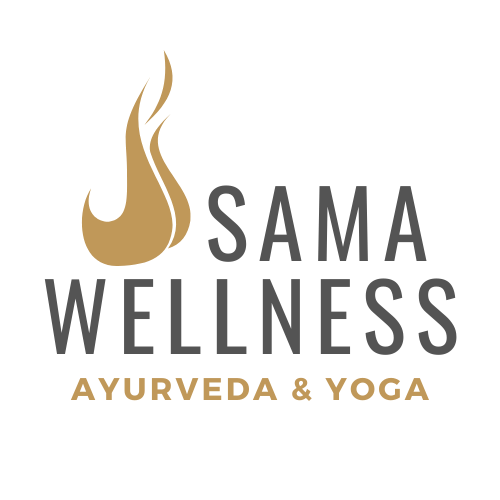Self-massage with oil, or abhyanga, is a wonderful practice for self care that is inexpensive, not time-consuming, and extremely beneficial. But you may have some questions if this is new to you or you haven’t yet made it part of your routine. My hope is that the following will serve as a straightforward guide to abhyanga: what you need, how and when to do it, and when not to do it.
What is abhyanga?
Sometimes called "oil bath," abhyanga is a type of self-massage with oil that is part of the Ayurvedic daily routine for balance and good health. The basic idea is 20 minutes of massaging warm oil into your skin, followed by a short warm shower.
What are the benefits?
According to Ayurveda, Vata is the energy of movement, activity, and creativity. It is present in all of us to varying degrees, and it is necessary for life to flourish, but if it increases too much it can cause serious problems. Vata is dry, cold, and fast-- to pacify it, therefore, we need to introduce practices that are oily, warm, and slow. Like oil massage! Abhyanga can improve your sleep, soothe a restless mind, downregulate your nervous system, pacify anxiety, improve circulation, and improve digestion. And it's not just for Vata individuals, though those with Vata aggravation likely need it the most. Signs that your Vata might be out of whack: dry skin, cracking or popping in the joints, mental fatigue, insomnia, anxiety, fear, constipation, gas, bloating.
What kind of oil should I use?
Use oil that is organic and cold-pressed. If you know your Prakrti (Ayurvedic constitution; most of us are dominant in one of the three doshas, Vata, Pitta or Kapha), you can choose this way: sunflower or coconut for Pitta, sesame or almond for Vata and Kapha. If you're not sure what your Prakrti is, think of your oil in terms of its heating or cooling effect: in the summer, coconut oil reduces excess heat, and in the winter sesame can warm you up. Banyan Botanicals has wonderful massage oils for every type that are infused with herbs if you want to get fancy.
When is abhyanga contraindicated?
One of the main benefits of abhyanga is that it can improve circulation. If your body is currently in a phase of cleansing (for example, when you're on your period), it is more beneficial to allow the down-and-out energy (apana) to finish its job than to stir things up. Wait until your flow is mostly finished before resuming your regular abhyanga.
Furthermore, if you have a lot of ama built up (think undigested gunk, toxins, etc), it may be beneficial to address this first before starting a daily abhyanga routine, for similar reasons. Digest first, then improve circulation. Same-same if you’re sick: wait until you’re over your cold or flu.
Lastly, and this should seem logical based on the above paragraphs, don't do abhyanga on a full stomach.
Ayurveda is an experiential science, and as such, your experience of the practices is very important. If oil bath feels like it’s increasing your pain or otherwise doesn’t feel right, skip it-- and consider making an appointment with an Ayurvedic health counselor or practitioner to figure out what would work better for you.
When should I do abhyanga?
Daily, in the morning before your yoga practice or exercise routine is best. Before a meal is also good. Just not after a meal. If you can't swing it daily, several times a week is also good-- build it into a routine of some sort, rather than just "whenever I have extra time."
What's the procedure?
Warm up your oil, by placing the bottle in a bowl of hot water.
Warm up your bathroom with a space heater, if necessary. You don't want to feel cold while you're doing this.
Designate some towels for this process that you're not too precious about, to dry off after you shower. They will get a little oily (and then use appropriate caution when washing and drying them).
Start your massage. Take your time, starting with your scalp and working downwards. Use circular strokes at the joints, long strokes on the bones. Don't forget your back (pro tip: use the back of your hands to reach your mid-back). A little extra attention on the places you feel creaky.
Take around ten minutes to apply the oil and maybe another ten minutes to go through the massage again.
Rub it in well. You should feel oily all over but not excessively slick.
Bonus time: sit on a towel and do a 5 or 10 minute meditation. This whole process is a time to be extremely present, so I'd advise against listening to podcasts or going over problems that need solving in your head.
Time to shower! Water should be warm, not hot. Use soap only on what actually needs washing -- you don't need to wash off the oil, but you can massage it in a little more with the warm water. Regular shampoo will work fine to get the oil off your scalp (unless you use castor oil, which is a post for another day).
Get out of the shower and pat yourself dry with your not-precious towel-- don't rub. You will likely still feel a little oily, which is just fine.
Be careful as you get out of the shower, which might be a little slick due to the oil. And clean up after yourself so the next person to use your shower doesn’t slip and put the kibosh on any future abhyanga activities!
Enjoy the benefits of your abhyanga.
I hope this guide was helpful! This is one of the most widely beneficial practices in Ayurveda, and I find myself recommending it to students frequently, especially through the dry cold fall and winter seasons here in Minnesota.

